|
Our Alaska pages:




trip&ship
animals
scenery and
wide panoramas
cool stuff
|
|
We humans have
an unending fascination with wildlife, and that is especially true for
those of us who live in crowded cities. Many of these animals were rather
far away, while others were "in captivity" (at an "animal hospital" that
shelters and takes care of hurt animals), but either way it was a
privilege to see these beautiful creatures in Alaska. (2008)
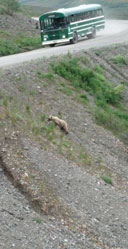
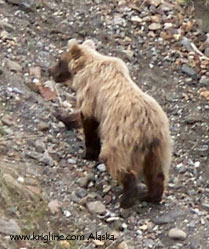
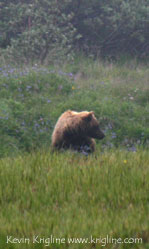
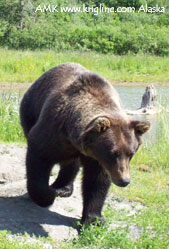
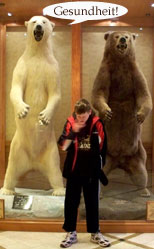
In Denali National Park, cars are only allowed in the first
sixty miles or so; the government runs a bus service on one of the few
roads, and we saw many things on our day-trip into one of America's most
"natural" and undisturbed preserves. The next-to-last photo was taken at
the "animal hospital." The last photo (of Andrew sneezing!) shows how big
these bears really are. |
|
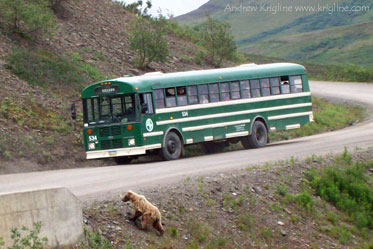
We watched this
bear for quite a while; those in the other bus got even closer photos! |
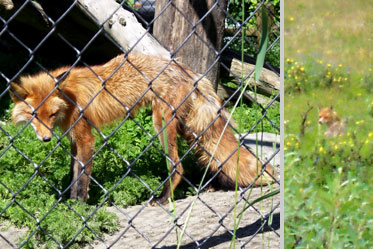
Next to the
"hospitalized" fox there's a picture of one we saw in person. |
|
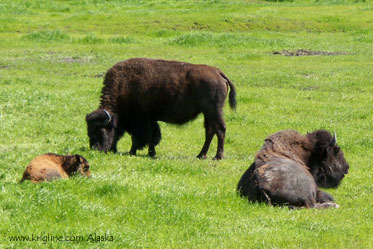
Buffalo or bison
at the "hospital." These huge animals were once hunted to almost
extinction, but they have made a big comeback. Some are even raised
domestically for food and fur. |
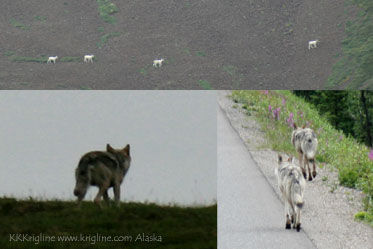
I saw mountain
sheep/rams much closer in Yellowstone National Park, but my brother got
this VERY distant shot with his long lens. He and Fran were also the only
ones who saw wolves in Denali. |
|
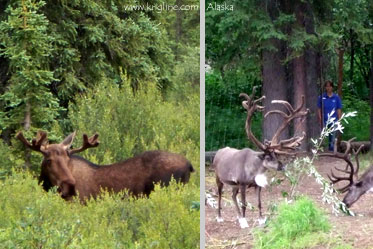
We saw
several moose (mooses? meece?) in
Denali; they are also huge. The reindeer are being raised domestically,
and we saw them on the paddleboat
tour. |
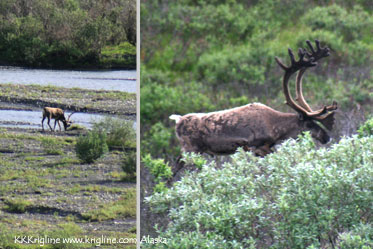
Again, Kevin's
long lens produced the best photos of these distant animals. I think the
one on the left is a caribou and the other is an elk, but I'm not sure! |
|
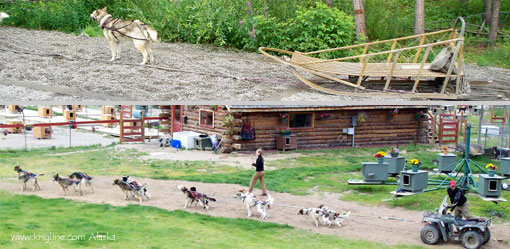
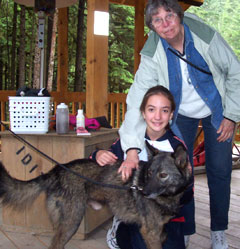
Since most of
Alaska is covered with snow most of the year, dog sleds have long been
used for winter transportation. There is even a famous, grueling race
called the Iditarod. Of course, training is a year-round process, and we
got to see several "working exhibits" like those shown above; these
hard-working dogs also love to meet new people (like Michael's mother and
niece in the last photo). |
|
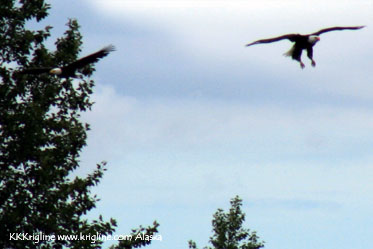
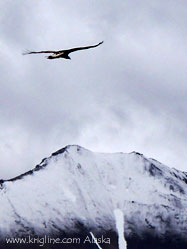

We saw lots of
eagles in Alaska, but of course it is hard to get photos! They fly very
high, and (except for the "bald" head) sort of blend in with the
background. Notice that there are two flying eagles in the first photo
(the other is in the tree). The bald eagle is another animal that has made
a come-back from the "endangered species" list. |
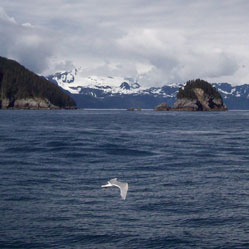 |
Rock islands,
like those shown in this picture, are home to many types of birds.
They nest in the rocks, and I can only imagine what this precarious home
is like in bad weather! Below you see sea gulls, a cormorant (I think) and
puffins. |
|
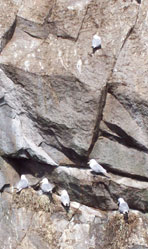
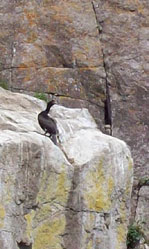

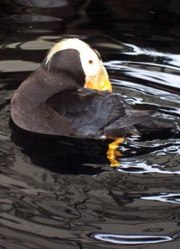
|
|

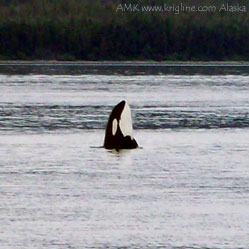
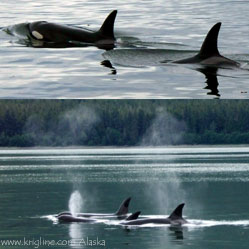
The whales were my favorite animal to watch, perhaps
because I'd never seen one in the wild before. Obviously I wasn't the only
one, because I had to choose from over 200 whale photos! These are Orca
whales, sometimes called killer whales. In fact, the middle picture shows
what they do to celebrate a kill (according to our guide). Whales are
mammals, so they breath air; the spray from their blowholes makes them
visible from a long way off. This was great for us (and our
sightseeing-boat captains), but it also made them easy to hunt (which is
no longer allowed in most countries). |
|
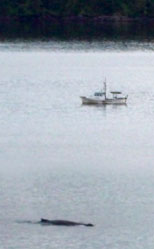
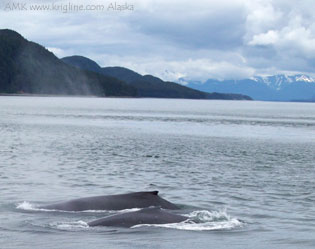

The first photo shows how big a humpback whale is, in comparison to a
fishing boat. Most of the time, all you can see is their "humped" back and
the spray from a blowhole, but just before they take a long dive
(sometimes for half an hour!) you can also see their tails. The last group
of photos is some of the tails we caught on film.
Click here to see a bigger Humpback whale tail. |
|
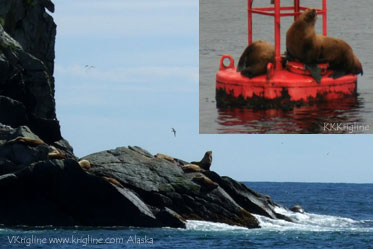
I would have
called these "seals" but I think the real term is "sea lions." |
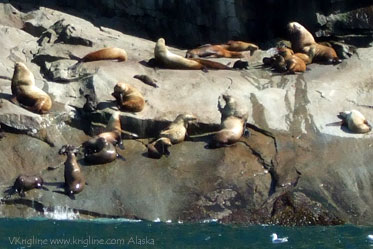
This is part of
a wider shot with over 100 sea lions basking in the sun. |
|
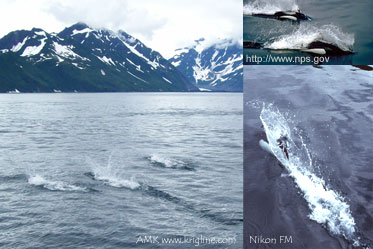
According to a
National Park Service website, "the Dallís Porpoise may be the fastest
small cetacean on the planet" with speeds reaching 30 knots (55 km/hr).
All we really saw was the spray they made as they "played" near our boat
in the Kenai Fjords. (source: www.nps.gov/kefj/dolphin) |
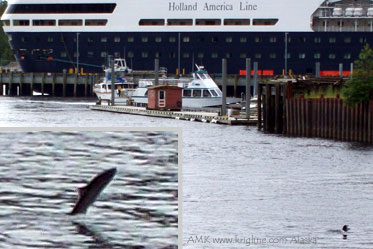
Salmon fishing
and canning is an important part of Ketchikan's economy; we saw these fish
jumping in the river that runs through town. Salmon have the interesting
instinct to return up-river to their birthplace in order to lay eggs; this
draws bears to the rivers because the jumping salmon are pretty easy to
catch! |
|

For our policy regarding copying or using photos/materials
on this website, click here. For more photos from (and a map of) the USA,
click here.
Our main Alaska pages:
trip&ship
animals
scenery and
wide panoramas
cool stuff
Click here for the "camera types"
used.
Vivian's Alaska photo album is also on line at
www.scrapbookflair.com/China_Doll
|


































